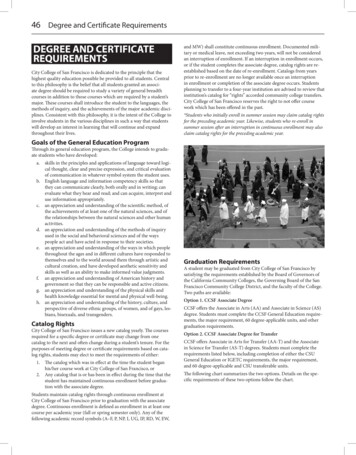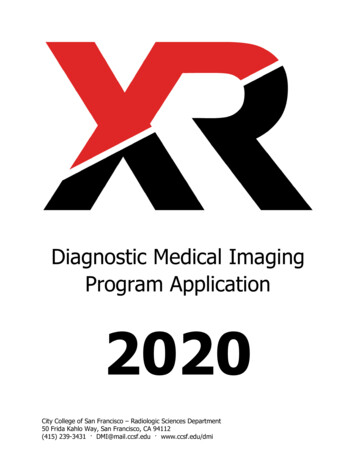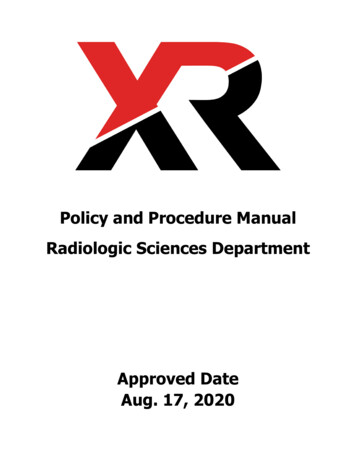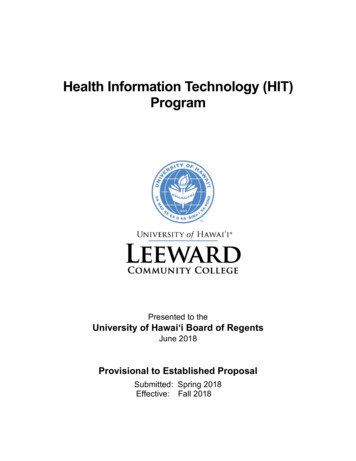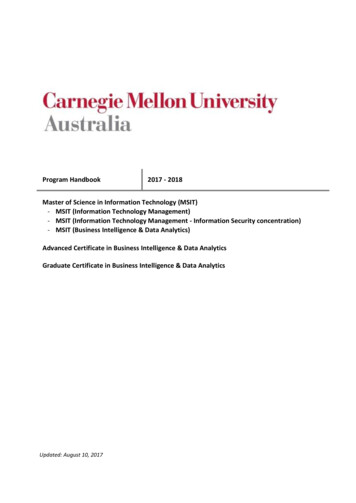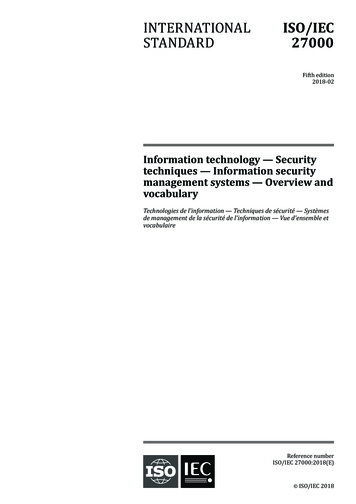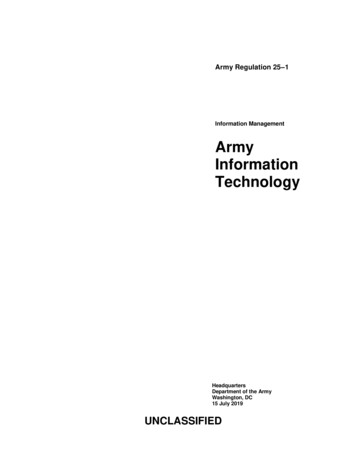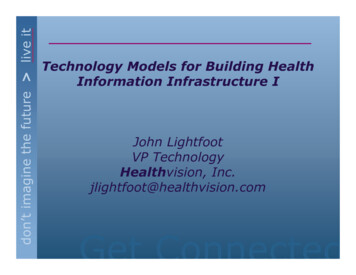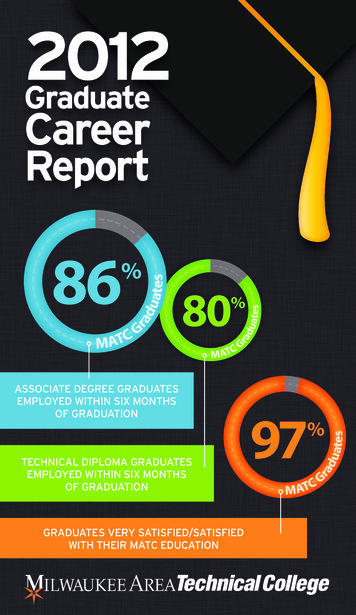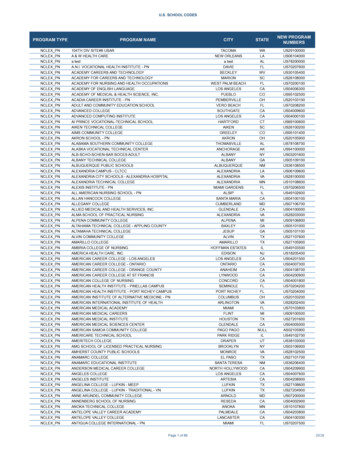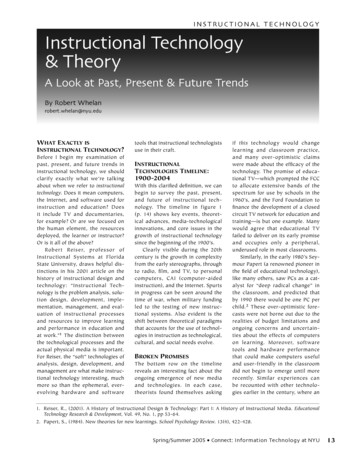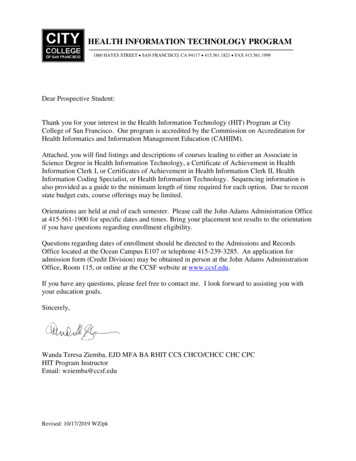
Transcription
HEALTH INFORMATION TECHNOLOGY PROGRAM1860 HAYES STREET SAN FRANCISCO, CA 94117 415.561.1821 FAX 415.561.1999Dear Prospective Student:Thank you for your interest in the Health Information Technology (HIT) Program at CityCollege of San Francisco. Our program is accredited by the Commission on Accreditation forHealth Informatics and Information Management Education (CAHIIM).Attached, you will find listings and descriptions of courses leading to either an Associate inScience Degree in Health Information Technology, a Certificate of Achievement in HealthInformation Clerk I, or Certificates of Achievement in Health Information Clerk II, HealthInformation Coding Specialist, or Health Information Technology. Sequencing information isalso provided as a guide to the minimum length of time required for each option. Due to recentstate budget cuts, course offerings may be limited.Orientations are held at end of each semester. Please call the John Adams Administration Officeat 415-561-1900 for specific dates and times. Bring your placement test results to the orientationif you have questions regarding enrollment eligibility.Questions regarding dates of enrollment should be directed to the Admissions and RecordsOffice located at the Ocean Campus E107 or telephone 415-239-3285. An application foradmission form (Credit Division) may be obtained in person at the John Adams AdministrationOffice, Room 115, or online at the CCSF website at www.ccsf.edu.If you have any questions, please feel free to contact me. I look forward to assisting you withyour education goals.Sincerely,Wanda Teresa Ziemba, EJD MFA BA RHIT CCS CHCO/CHCC CHC CPCHIT Program InstructorEmail: wziemba@ccsf.eduRevised: 10/17/2019 WZ/pk
PROGRAM OVERVIEWThe Health Information Technology (HIT) curricula provides competency-based instruction andprofessional practice experience to assist students in developing the theoretical and technicalskills necessary for graduates to demonstrate competency in collecting, retaining, and reportinghealth information data and to prepare students to take the national certification examination toearn the Registered Health Information Technician (RHIT) credential through the AmericanHealth Information Management Association.The curricula are based on an explicit set of competencies. These competencies have beendetermined through job analyses conducted by health information practitioners. Thecompetencies are subdivided into domains, subdomains, and tasks. Tests are structured anddeveloped to measure a student’s cognitive skill level in the areas of recall, application, andanalysis.Students in the HIT program may enroll and take courses on a part-time or full-time basis. Thenumber of semesters needed to complete the degree program or certificate program(s) will vary.WHAT ARE HEALTH INFORMATION TECHNICIANS?Health Information Technicians play a critical role in maintaining, collecting, analyzing,integrating, protecting, securing and managing healthcare information that doctors, nurses andother healthcare providers rely on to deliver quality healthcare.Health Information Technology prepares individuals with a desire to work in health care settingswhere health information is used. A career as a health information management professionaloffers a unique opportunity to be at the forefront of the healthcare industry where healthcaremeets the cutting edge of technology and a member of the healthcare team. The increasing useof electronic health records will continue to broaden and will result in more career opportunitiesfor trained health information technicians. This is one of the few health occupations in whichthere is little or no direct contact with patients.NATURE OF THE WORKProfessionals holding the RHIT credential are health information technicians who: Tabulate and analyze medical data for administrative, regulatory, and legislativerequirements. Abstract health data for reporting, medical reviews, administration, and legal proceedings. Assure patient privacy, confidentiality, and security of health information. Assign a numeric code to each diagnosis and procedure using coding classification schemesfor billing, reimbursement, and reporting purposes. Perform clinical quality assessment and improvement activities. Participate in design and transition to the electronic health record. Supervise health information management and related staff. Support patient safety and quality improvement efforts and requirements in all healthcaresettings.2
EDUCATION AND TRAININGEntry-level health information technicians usually have an associate degree in HealthInformation Technology. Many employers favor technicians who have a RHIT credential.Typical course work in Health Information Technology includes medical terminology, anatomyand physiology, health data requirements and standards, legal aspects, clinical classification andcoding systems, data analysis, health care reimbursement methods, database security andmanagement, and quality improvement methods.Health information technicians and coders should possess good oral and written communicationskills as they often serve as liaisons between healthcare facilities and healthcare providers.Individual’s proficient with computer software and technology will be appealing to employers ashealthcare facilities continue to adopt electronic health records.CERTIFICATIONSuccessful graduates with an Associate in Science Degree in Health Information Technologywill become eligible to take the national certification examination given by the AHIMA to earnthe Registered Health Information Technician (RHIT) credential. Candidates who pass thewritten examination are required to maintain their credential through continuing education units.ELIGIBILITY REQUIREMENTSRHIT applicants must meet one of the following eligibility requirements: Successfully complete the academic requirements at the associate degree level, of an HIMprogram accredited by the CAHIIM.Graduate from an HIM program approved by a foreign association with which AHIMA has areciprocity agreement.The academic qualifications of each candidate will be verified before a candidate is deemedeligible to take the examination. All first-time applicants must submit an official transcriptfrom their college or university.ADVANCEMENTCredentialed health information technicians may have the opportunity to supervise or manage anHIM department or outpatient care centers.Health information technicians have an opportunity to advance their careers by obtaining abachelor’s degree or master’s degree. A bachelor’s may be required to become a healthinformation manager. Medical and health services managers held about 283,500 jobs in 2008.Master’s and doctoral degree programs in health administration, health informatics, etc. areoffered by colleges; universities; and schools of public health, medicine, allied health, publicadministration, and business administration.3
EMPLOYMENT OPPORTUNITIES AND THE FUTUREJob OutlookAccording to the United States Bureau of Labor Statistics, Health Information Technology is oneof the 20 fastest growing occupations in the United States. Health information managementprofessionals are in high demand across the nation in a variety of work settings.Although most RHITs work in hospitals and outpatient care centers, employment opportunitiesmay be found in public health facilities, consulting firms, long term and rehabilitation carefacilities, physician offices, medical billing firms, home health and hospice agencies, behavioralhealth facilities, correctional facilities, state and federal health agencies, private industry,pharmaceutical companies, cancer registries, law and insurance firms, quality management andresearch, peer review organizations, and health product vendors. RHIT’s can also work in salesand marketing positions for companies that design and supply information systems and materialsfor health information departments.It is projected that health information technicians will hold 207,600 jobs by 2018. This is anexpected increase of 20 percent and faster than the average because of rapid growth in thenumber of medical tests, treatments, and procedures that will be increasingly scrutinized bythird-party payers, regulators, courts, and consumers.The groundbreaking American Recovery and Reinvestment Act (ARRA) of 2009 and the HealthInformation Technology for Economic and Clinical Health (HITECH) Act which is part ofARRA offers the healthcare sector exceptional opportunities for job prospects associated withthe delivery of healthcare, health information systems, and in the use, management, and analysisof patient-related information. Job growth will result from the core of information managementand health information technology (health IT), which is the EHR.The healthcare industry has a shortage of health care workers qualified to create and maintainelectronic records systems, build health information exchanges, deal with HIPAA privacy andsecurity standards and regulations, personal health records, workforce initiatives, and providetraining for ICD-10. In addition, numerous job openings will result from the need to replacehealth information technicians who retire or leave the occupation permanently.EarningsBased on the Occupational Outlook Handbook, current edition, the median annual earning ofmedical records and health information technicians was 30,610 in May 2008. The middle 50percent earned between 24,290 and 39,490. The lowest 10 percent earned less than 20,440and the highest 10 percent earned more than 50,000. About 39 percent worked in hospitals.Median annual wages in the industries employing the largest numbers of medical records andhealth information technicians in May 2008 were Federal Executive Branch 42,760, Generalmedical and surgical hospital 32,600, Nursing care facilities 30,660, Outpatient care centers 29,160 and Offices of physicians 26,210.Job outlook and earnings information was obtained from the Bureau of Labor Statistics, U.S.Department of Labor, Occupational Outlook Handbook, current edition, Medical Records andHealth Information Technicians, and on the Internet at http:// www.bls.gov/oco/ocos103.htm(Visited October, 2013)4
Sources of Additional InformationThe Commission on Accreditation for Health Informatics and Information ManagementEducation (CAHIIM)200 East Randolph Street, Suite 510Chicago, IL 60601Phone: (312) 235-3255info@cahiim.orgThe American Health Information Management Association233 N. Michigan Avenue, Suite 2150Chicago, IL 60601-5800http://www.ahima.org ORPhone: (312) 233-1090http://himcareers.ahima.orgRelated Links:The California Health Information Association1915 N. Fine Avenue, Suite 104Fresno, CA 93727-1510Phone: (559) 251-5038http://www.CaliforniaHIA.orgThe National Cancer Registrars Association1340 Braddock Place, #203Alexandria, VA 22314http://www.ncra-usa.orgU.S. Department of Labor, Bureau of Labor StatisticsOccupational Outlook Handbook Projections2 Massachusetts Avenue, Suite 2135 NEWashington, DC 20212-0001Phone: (202) 691-5700http://www.bls.gov/OCOAmerican Academy of Professional Coders2480 South 3850 West, Suite BSalt Lake City, UT 84120http://www.aapc.com5
CurriculumASSOCIATE IN SCIENCE DEGREE IN HEALTH INFORMATION TECHNOLOGYTo earn the Associate in Science Degree in Health Information Technology, students mustcomplete BOTH Health Information Technology Curricula with a 2.0 grade point average andGeneral Education Requirements from the College.Students holding an associate’s degree, baccalaureate degree or higher in a discipline from anAccredited institution of post-secondary education must petition for the Associate in ScienceDegree in Health Information Technology. A previous degree does not automatically meetGeneral Education Requirements. (See current CCSF Catalog for concise lists and descriptionsof General Graduation Requirements Areas A-H).All first-time applicants must submit an official transcript from their college or university forevaluation toward CCSF’s requirements. The academic qualifications of each candidate will beverified before a candidate is deemed eligible to take the national examination.Successful graduates with an Associate in Science Degree in Health Information Technology areeligible to take the national certification exam approved by the American Health InformationManagement Association to earn the Registered Health Information Technician (RHIT)credential. Upon completion of the degree program in Health Information Technology, thestudent will be able to: Demonstrate record management skills and knowledge necessary for HIM entry-levelemployment as a health information professional invarious health care settings Demonstrate the technical skills and knowledge necessary for HIM entry level employment asa health information professional in varioushealth care settings Demonstrate the behavioral, interpersonal, ethical and professional skills necessary for HIMemployment as a health information professionalin various health care setting Apply for the Certified Coding Associate (CCA) national certification examination offered bythe American Health Information Management Association (AHIMA) Apply for the Registered Health Information Technician (RHIT) national exam offered byAHIMA.6
FIRST SEMESTER (12 units)BIO 106INTRODUCTION TO HUMAN ANATOMY AND PHYSIOLOGYHCT 61INTRODUCTION TO HEALTH CARE (fall/spring)HIT 50AMEDICAL TERMINOLOGY I (fall/spring)HCT 67COMPUTER APPLICATIONS IN HEALTH CARE (fall/spring)4332SECOND SEMESTER (12 units**)HIT 50BMEDICAL TERMINOLOGY II (fall/spring)HIT 57DISEASE PROCESS (fall/spring)HIT 63HEALTH INFORMATION SYSTEMS (spring only)HIT 65ORGANIZATION OF HEALTH DATA (spring only)HIT 73AICD-10-CM CODING (fall and spring)23322THIRD SEMESTER (12 units**)HIT 72LEGAL ASPECTS OF HIM (fall only)HIT 73BICD-10-CM/PCS CODING (spring only)HIT 77APROFESSIONAL PRACTICE EXPERIENCE I (fall/ spring)HIT 74INTRODUCTION TO QUALITY IMPROVEMENT (spring only)3452FOURTH SEMESTER (11 units**)HIT 75ORGANIZATION AND SUPERVISION (fall only)HIT 76CPT CODING (fall/spring only)HIT 77BPROFESSIONAL PRACTICE EXPERIENCE II (fall/spring)HIT 78REIMBURSEMENT METHODS IN HIM (spring only)3352*Associate in Science Degree in Health Information Technology requires 47 units.7
Certificate CurriculaStudents may obtain a Certificate of Accomplishment in Health Information Clerk I or Certificateof Achievement in Health Information Clerk II, Health Information Coding Specialist, MedicalTranscription, and Health Information Technology by completing the curriculum with a finalgrade point average of 2.0 or higher and also complete each individual course with a final grade ofC or higher or Pass.The certificates options are:Health Information Clerk IHealth Information Clerk IIHealth Information Coding SpecialistHealth Information Technology(requires 15 units)(requires 33 units)(requires 41 units)(requires 47 units)CERTIFICATE OF ACCOMPLISHMENT PROGRAM FOR HEALTH INFORMATIONCLERK I (15 UNITS)This certificate program prepares students for entry-level positions in health informationmanagement departments. Opportunities for employment include reception, admittingdepartment functions, scanning of documents, filing and retrieval of records, filing and sortingloose documents, purging of records, storage and retention activities, data entry, processingadmissions and discharges, and assembly of medical documents in a sequential order. Uponcompletion of the Health Information Clerk I Certificate of Accomplishment, students will beable to: Demonstrate record management skills and knowledge necessary for HIM entry-levelemployment as a health information professional in various health care settings. Perform computer applications necessary for HIM entry-level employment as a healthinformation professional. Demonstrate the behavioral, interpersonal, ethical and professional skills necessary for HIMemployment as a health information professional in various health care settings.ONE SEMESTER (15 units)BIO 106INTRODUCTION TO HUMAN ANATOMY AND PHYSIOLOGYHCT 61INTRODUCTION TO HEALTH CARE (fall/ spring)HIT 50AMEDICAL TERMINOLOGY I (fall/spring)HCT 67COMPUTER APPLICATIONS IN HEALTH CARE (fall/spring)ENGL 86 or BASIC COMPOSITION AND READING I orESL 150INTERMEDIATE COMPOSITION AND READING423238
CERTIFICATE OF ACHIEVEMENT PROGRAM FOR HEALTH INFORMATIONCLERK II (33 UNITS)This certificate program prepares students for technical positions in health informationmanagement departments. Employment opportunities include working in a hybrid and electronichealth record environment, analyzing health records for deficiencies according to establishedstandards; maintaining and using a variety of indices and storage retrieval systems; managing theusage and release of health information; collecting and abstracting health data for statisticalpurposes, assignment of codes according to specific classification systems and use of officialcoding guidelines for reimbursement, billing, and reporting purposes. Upon completion of theHealth Information Clerk II Certificate of Achievement, students will be able to: Demonstrate record management skills and knowledge necessary for HIM entry-levelemployment as a health information professional in various health care settings Perform computer applications necessary for HIM entry-level employment as a healthinformation professional in various health care settings Demonstrate technical skills and knowledge necessary for HIM entry-level employment as ahealth information professional in various health care settings Demonstrate the behavioral, interpersonal, ethical and professional skills necessary for HIMemployment as a health information professional in various health care settingsFIRST SEMESTER (15 units)BIO 106INTRODUCTION TO HUMAN ANATOMY AND PHYSIOLOGYHCT 61INTRODUCTION TO HEALTH CARE (fall/spring)HIT 50AMEDICAL TERMINOLOGY I (fall/ spring)HCT 67COMPUTER APPLICATIONS IN HEALTH CARE (fall/spring)ENGL 86 or BASIC COMPOSITION AND READING I orESL 150INTERMEDIATE COMPOSITION AND READINGSECOND SEMESTER (17-18 units)HIT 50BMEDICAL TERMINOLOGY II (fall/spring)HIT 63HEALTH INFORMATION SYSTEMS (spring only)HIT 65ORGANIZATION OF HEALTH DATA (spring only)HIT 72LEGAL ASPECTS OF HIM (fall only)HIT 73AICD-10-CM CODING (fall and spring)HIT 77APROFESSIONAL PRACTICE EXPERIENCE I (fall/spring)MATH 840* ELEMENTARY ALGEBRA423232333353* Required based on college math placement test score for students. PREREQ: MATH E1, E2OR E3, OR EX, OR BSMA G, H, OR J, OR PLACEMENT IN MATH 8409
CERTIFICATE OF ACHIEVEMENT PROGRAM FOR HEALTH INFORMATIONCODING SPECIALIST*This certificate program prepares students to assign diagnostic and procedural codes supportedby medical documentation in accordance with official coding and reporting guidelines andcompliance regulations. Students choose reportable codes to use on exercises, case scenarios,and actual patient records with basic to moderate and advanced clinical complexity.Students learn to read, analyze, compile, and interpret documentation in the health record andapply knowledge of anatomy and physiology, medical terminology, clinical disease process,pharmacology, and understand lab values to assigning accurate codes. Students are introduced toassign code(s) manually and with utilizing information technology systems.Employment opportunities as a coder include acute care hospitals, physicians’ offices, clinics,ambulatory care facilities, long-term care, behavioral health, home health and hospice agencies,health product vendors, state and federal agencies, billing and financial services, utilizationreview, quality improvement areas, compliance, and other healthcare settings. Upon completionof the Health Information Coding Specialist Certificate in Health Information Technology,students will be able to: Assign diagnosis/procedures using the International Classification of Diseases (ICD) officialcoding guidelines for inpatient and outpatient
Degree in Health Information Technology. A previous degree does not automatically meet General Education Requirements. (See current CCSF Catalog for concise lists and descriptions of General Graduation Requirements Areas A-H). All first-time applicants must submit an official transcript from their college or university for
